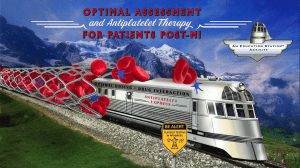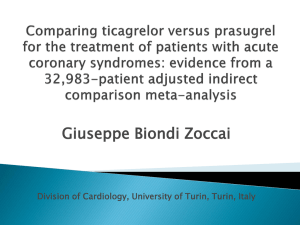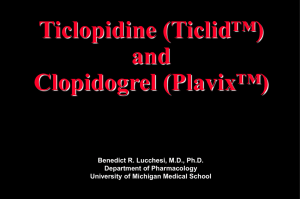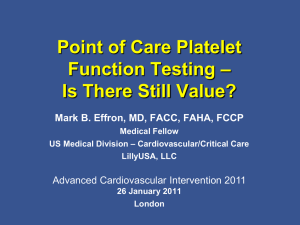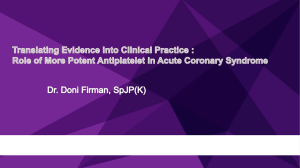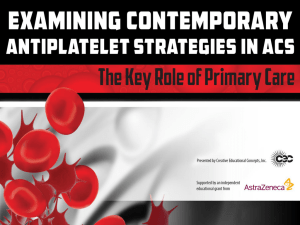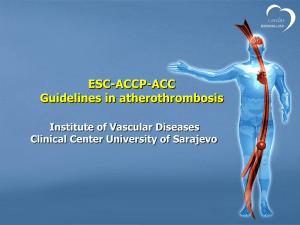Online appendix to `Inhibitory Effects of Ticagrelor Compared to
advertisement
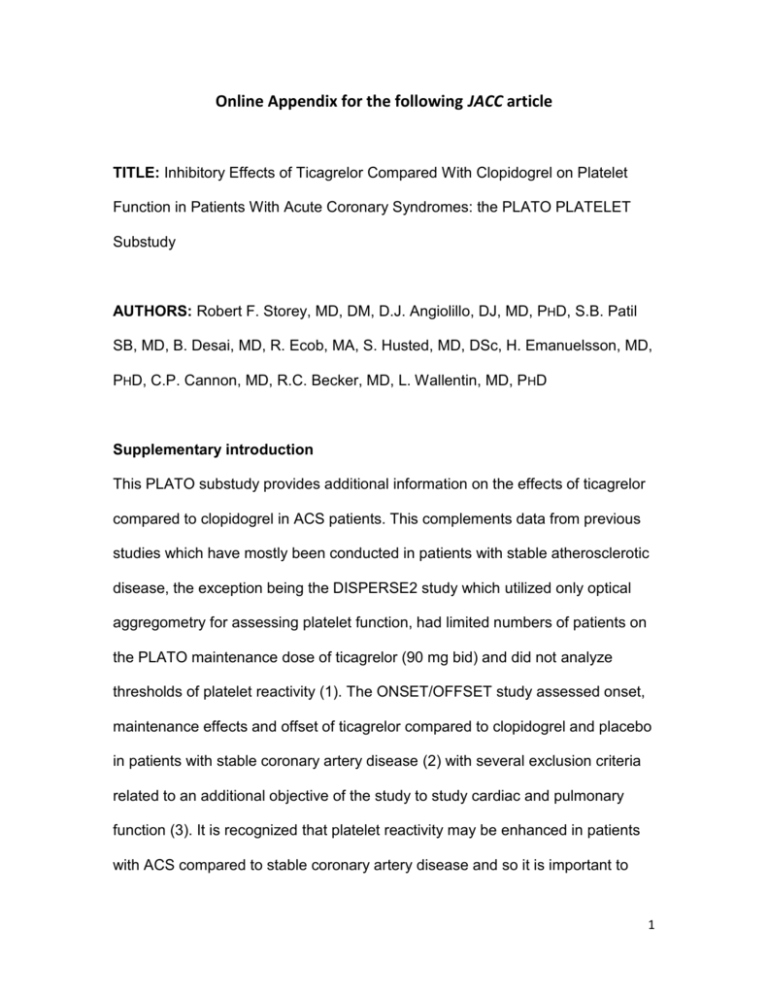
Online Appendix for the following JACC article TITLE: Inhibitory Effects of Ticagrelor Compared With Clopidogrel on Platelet Function in Patients With Acute Coronary Syndromes: the PLATO PLATELET Substudy AUTHORS: Robert F. Storey, MD, DM, D.J. Angiolillo, DJ, MD, PHD, S.B. Patil SB, MD, B. Desai, MD, R. Ecob, MA, S. Husted, MD, DSc, H. Emanuelsson, MD, PHD, C.P. Cannon, MD, R.C. Becker, MD, L. Wallentin, MD, PHD Supplementary introduction This PLATO substudy provides additional information on the effects of ticagrelor compared to clopidogrel in ACS patients. This complements data from previous studies which have mostly been conducted in patients with stable atherosclerotic disease, the exception being the DISPERSE2 study which utilized only optical aggregometry for assessing platelet function, had limited numbers of patients on the PLATO maintenance dose of ticagrelor (90 mg bid) and did not analyze thresholds of platelet reactivity (1). The ONSET/OFFSET study assessed onset, maintenance effects and offset of ticagrelor compared to clopidogrel and placebo in patients with stable coronary artery disease (2) with several exclusion criteria related to an additional objective of the study to study cardiac and pulmonary function (3). It is recognized that platelet reactivity may be enhanced in patients with ACS compared to stable coronary artery disease and so it is important to 1 study platelet function in the ACS population to confirm findings in patients with stable disease (4,5). It has not previously been studied whether proton pump inhibitors affect the inhibitory action of ticagrelor on platelet function. Additional details of methods Inclusion and exclusion criteria Inclusion criteria for the substudy were the same as for the main PLATO study. Eligible patients for the PLATO study were required to have onset of chest pain of ischemic origin within the previous 24 hours, age greater than 18 years, and either persistent ST segment elevation (or left bundle branch block) with primary PCI planned or two of three of the following: (i) ischemic ST segment depression or transient elevation; (ii) elevated cardiac biomarkers; and (iii) at least one of a number of additional risk factors (including age more than 60 years, diabetes mellitus, previous MI or stroke, and chronic renal dysfunction). Exclusion criteria for the PLATO PLATELET substudy were the same as for the main study (6) with the addition of the following: (i) dipyridamole, cilostazol or glycoprotein IIb/IIIa antagonist therapy within the last 7 days; (ii) ticlopidine therapy within the last 14 days. Ethical and regulatory approval Separate informed consent was provided according to a protocol approved by the local ethical review committees and regulatory authorities. 2 Study medication All patients in the main PLATO study received aspirin 75-325 mg daily (unless allergic or intolerant) and were randomized to receive, in a double-blind, doubledummy design, either clopidogrel 300 mg loading dose (if clopidogrel-naive), with an optional additional clopidogrel 300 mg loading dose prior to PCI to make a total of 600 mg, followed by clopidogrel 75 mg daily (as well as placebo ticagrelor tablets twice daily) or ticagrelor 180 mg loading dose followed by ticagrelor 90 mg twice daily (as well as placebo clopidogrel capsules) (7). Time points of assessment For assessment of the effects of maintenance therapy, patients at two centers (Northern General Hospital ,Sheffield, United Kingdom, and University of Florida College of Medicine, Jacksonville, Florida, United States) were studied after receiving at least 28 days of study medication and had blood samples collected prior to the next maintenance dose and then 2-4 hours post dose. These patients did not require any baseline blood sample collection and there was no requirement for patients to have been clopidogrel-naive at randomization. For assessment of the onset of action of the loading doses, a subset of patients in a single center (Northern General Hospital, Sheffield, United Kingdom) who had not received clopidogrel within the previous 14 days were enrolled in the substudy at the same time as enrolment in the main PLATO study. In these patients, samples were collected prior to administration of study medication (‘baseline’) and subsequently at 1, 2, 4, 8 and 12 hours post study medication 3 (ticagrelor or clopidogrel loading doses). These patients were subsequently further studied after 28-38 days of treatment with ticagrelor or clopidogrel and blood samples were collected prior to the next maintenance dose and then 2, 4 and 8 hours after this maintenance dose. Light transmittance aggregometry Preparation of platelet-rich plasma (PRP) commenced within 15 minutes of blood collection with centrifugation of citrate-anticoagulated blood for 10 minutes at 180 g to obtain the supernatant PRP. The residual blood was then centrifuged for 10 minutes at 1500 g to obtain platelet-poor plasma (PPP). PPP was used to adjust the platelet count of the PRP to 250,000 platelets/mL. Light transmittance aggregometry was performed no later than one hour after blood collection using a Chronolog 490 2-channel aggregometer in both UK and US centers. Inhibition of platelet aggregation (IPA) was determined for the subset of clopidogrel-naive patients with baseline (pre-treatment) samples using the formula: % IPA = ((Baseline aggregation response - Post dose aggregation response)/Baseline aggregation response) x 100. VerifyNow P2Y12 assay VerifyNow P2Y12 cartridges contain fibrinogen-coated beads, ADP as agonist, and the inhibitor PGE1, which amplifies the effects of P2Y12 inhibition. A separate channel in the cartridge contains thrombin receptor activating peptide (TRAP) instead of ADP and PGE1 and this is proposed to provide an estimate of the 4 expected response in the absence of P2Y12 inhibition (8,9). For assessment of maintenance therapy, the assay was performed prior to maintenance dose and 2-4 hours post dose. For assessment of onset of effect of the loading doses of study medication, the assay was performed at baseline and 4 hours post dose. VASP phosphorylation assay Aliquots of whole blood were mixed with saline control, PGE1 alone or PGE1 plus ADP using a kit for assessment of P2Y12-mediated inhibition of PGE1–induced VASP phosphorylation (10). After 5 min, samples were fixed and permeabilizing solution added prior to addition of fluorescent antibodies mediated against both CD42a and either VASP or isotype control. Median fluorescent values were assessed by flow cytometry for the responses with PGE1 alone and with PGE1 plus ADP. Platelet reactivity index (PRI) was determined using the formula: PRI = ((PGE1 response - PGE1 + ADP response)/ PGE1 response) x 100%. This assay was performed at the same time points as VerifyNow P2Y12. Statistical analysis Platelet function data obtained following administration of a glycoprotein IIb/IIIa antagonist during the onset phase were excluded from analysis except for VASP phosphorylation assay data. Supplementary results Study population 5 The 5 patients receiving clopidogrel 600 mg were STEMI patients undergoing primary PCI and 3 of these received abciximab after randomization so that full aggregation data was only available for 2 patients. However, available data for the different loading doses of clopidogrel did not show greater inhibition with the higher loading dose and so are presented together except where indicated in the text. 2 ticagrelor-treated patients also received abciximab. Some ticagrelortreated NSTEMI patients received an additional dose of ticagrelor 90 mg prior to PCI but this was after the 12-hour assessment of the onset of effects of study treatment. VerifyNow P2Y12 assay There was evidence of inhibition of the VerifyNow P2Y12 TRAP channel response with increasing inhibition of the ADP/PGE1 response suggesting that this response may not be ideal for providing an estimate of the expected ADP/PGE1 response in the absence of P2Y12 inhibition: clopidogrel group TRAP responses were 315 ± 54 and 308 ± 47 PRU and ticagrelor group TRAP responses were 288 ± 54 and 275 ± 51 PRU at trough and peak respectively (P = 0.003 for clopidogrel trough vs. ticagrelor peak responses). VASP phosphorylation assay Of the clopidogrel group, mean PRI 4-hours post dose was 61.3 ± 12.0 and 51.1 ± 18.5 in those who received 300 mg and 600 mg loading doses respectively (p = ns). 6 Effects of other comedications As shown in Table 2, the numbers of patients not receiving a statin or receiving calcium channel blockers were insufficient to allow assessment of any effects of these co-medications. Few patients in either center were taking an aspirin dose greater than 81 mg daily (Table 2) and responses appeared similar in those taking aspirin 300-325 mg daily (n = 4 and 3 for clopidogrel and ticagrelor group, respectively) compared to the lower doses: for the low dose of aspirin versus high dose aspirin, the VerifyNow P2Y12 responses at 2-4 hours post dose were 192 ± 96 vs. 221 ± 97 PRU for clopidogrel and 32 ± 33 vs. 28 ± 28 for ticagrelor, respectively (all p = NS). Inhibition of platelet aggregation The onset of IPA was more rapid in the ticagrelor group following the loading dose compared to clopidogrel and IPA was greater over the 12 hour period postdosing in the ticagrelor group (Figures 4A & B). At 1 hour post dose, the IPA (maximum response to ADP 20 M) was 25 ± 17% for clopidogrel and 54 ± 23% for ticagrelor (P < 0.01). Supplementary discussion The use of thresholds of platelet reactivity to determine ischemic risk is supported by numerous studies that have shown increased risks of ischemic events, particularly those provoked by stent thrombosis, in clopidogrel-treated 7 patients with high platelet reactivity measured by different platelet aggregation methods and other assays of P2Y12 inhibition, including all the methods used in this study (11-19). It is apparent that the VASP assay detects a greater proportion of ‘poor response’ to clopidogrel compared to the other assays, raising the question of how discriminating this assay might be between moderate and poor responders determined by the other assays. Recent data indicate that the VASP assay is insensitive to even moderate degrees of P2Y12 receptor blockade (up to 50%) and is best at determining whether or not a high degree of receptor blockade is present.(20) The optimum levels of receptor blockade in different clinical settings remain to be determined. There are concerns that co-prescription of some medications may reduce the response to clopidogrel, potentially increasing the risk of ischemic events, and recent data indicate that proton pump inhibitors may attenuate the response to clopidogrel (21,22) although whether this has an impact on clinical outcomes remains controversial. The higher ischemic risk of patients prescribed proton pump inhibitors is supported by the observation that the ischemic event rates in the PLATO study were higher in patients taking proton pump inhibitors in both the clopidogrel and ticagrelor groups with similar relative risk reductions with ticagrelor in those taking and not taking proton pump inhibitors at randomization (7). Whilst more intense P2Y12 inhibition is associated with lower risk of recurrent ischemic events, it is also generally associated with increased risk of bleeding (23-25). However, the PLATO study did not show any significant excess 8 of major bleeding with ticagrelor compared to clopidogrel(7) despite the more intense P2Y12 inhibition demonstrated in this PLATO substudy. Partly, this may be explained by the reversibility of effect of ticagrelor (2) which likely explains the non-significant trend towards lower incidence of major bleeding associated with CABG surgery in the PLATO study (7). There was a higher incidence of nonCABG related bleeding with ticagrelor compared to clopidogrel in PLATO, which is consistent with the effects of more intense P2Y12 inhibition on hemostasis. The finding that the TRAP channel on the VerifyNow P2Y12 assay was inhibited by ticagrelor in comparison with clopidogrel is relevant in interpretation of percentage inhibition results determined by this assay. Our findings suggest that the use of the TRAP channel for determining percentage inhibition in the context of high-level P2Y12 inhibition may be a source of error since the TRAP channel value will be lower than it would be in the absence of P2Y12 inhibition and therefore not provide a reliable estimate of baseline response. It is well recognized that activation of the P2Y12 receptor by ADP, released in response to stimulation by TRAP, plays an important role in amplifying TRAP-induced platelet aggregation (26,27) so our findings are not unexpected. Other limitations of this substudy were insufficient numbers of clopidogrelnaive patients receiving the standard and double loading dose of clopidogrel to compare each separately with the ticagrelor loading dose and insufficient numbers in the maintenance phase to analyze completely the effects of potential drug interactions on response to clopidogrel, although these have been comprehensively studied and reported elsewhere (28). Pharmacokinetic samples 9 were not collected simultaneous to the samples for platelet function analysis to allow assessment of relationships between the two. Furthermore, this substudy was not powered to assess the relationship between pharmacodynamic data and clinical outcomes. Different light transmittance aggregometers potentially have different calibration for determining percentage platelet aggregation and this could have an influence on the absolute values of risk thresholds determined by LTA. The study by Hochholzer et al used a BioData PAP4 aggregometer(29) whilst the OPTIMUS study used a Chronolog 490 aggregometer,(30) as in this study. This remains a limitation in the comparison of different studies that have such methodological differences. Acknowledgements We are grateful to Inger Ekman for assistance with coordinating the multi-center aspects of the substudy. 10 References to online Appendix 1. Storey RF, Husted S, Harrington RA, et al. Inhibition of Platelet Aggregation by AZD6140, A Reversible Oral P2Y12 Receptor Antagonist, Compared With Clopidogrel in Patients With Acute Coronary Syndromes. J Am Coll Cardiol 2007;50:1852-1856. 2. Gurbel PA, Bliden KP, Butler K, et al. Randomized Double-Blind Assessment of the ONSET and OFFSet of the Antiplatelet Effects of Ticagrelor versus Clopidogrel in Patients with Stable Coronary Artery Disease: The ONSET/OFFSET Study. Circulation 2009;120:2577-85. 3. Storey RF, Bliden K, Patil SB, et al. Abstract 5768: The Effect of Ticagrelor on Cardiopulmonary Function in Patients With Stable Coronary Artery Disease. Circulation 2009;120:S1145-a-. 4. Geisler T, Kapp M, Göhring-Frischholz K, et al. Residual platelet activity is increased in clopidogrel- and ASA-treated patients with coronary stenting for acute coronary syndromes compared with stable coronary artery disease. Heart 2008;94:743-747. 5. Sibbing D, von Beckerath O, Schömig A, Kastrati A, von Beckerath N. Platelet function in clopidogrel-treated patients with acute coronary syndrome. Blood Coagulation & Fibrinolysis 2007;18:335-339. 6. James S, Åkerblom A, Cannon CP, et al. Comparison of Ticagrelor, the first reversible oral P2Y12 receptor antagonist, with clopidogrel in patients with acute coronary syndromes: rationale, design, and baseline 11 characteristics of the PLATelet inhibition and patient Outcomes (PLATO) trial. Am Heart J 2009;157:599-605. 7. Wallentin L, Becker RC, Budaj A, et al. Ticagrelor versus Clopidogrel in Patients with Acute Coronary Syndromes. N Engl J Med 2009;361:10451057. 8. Malinin A, Pokov A, Spergling M, et al. Monitoring platelet inhibition after clopidogrel with the VerifyNow-P2Y12® rapid analyzer: The VERIfy Thrombosis risk ASsessment (VERITAS) study. Thromb Res 2007;119:277-284. 9. Angiolillo DJ, Costa MA, Shoemaker SB, et al. Functional Effects of High Clopidogrel Maintenance Dosing in Patients With Inadequate Platelet Inhibition on Standard Dose Treatment. The American Journal of Cardiology 2008;101:440-445. 10. Aleil B, Ravanat C, Cazenzve JP, Rochoux G, Heitz A, Gachet C. Flow cytometric analysis of intraplatelet VASP phosphorylation for the detection of clopidogrel resistance in patients with ischemic cardiovascular diseases. J Thromb Haemost 2005;3:85-92. 11. Gurbel PA, Bliden KP, Guyer K, et al. Platelet Reactivity in Patients and Recurrent Events Post-Stenting: Results of the PREPARE POSTSTENTING Study. J Am Coll Cardiol 2005;46:1820-1826. 12. Cuisset T, Frere C, Quilici J, et al. Predictive Values of Post-Treatment Adenosine Diphosphate-Induced Aggregation and Vasodilator-Stimulated Phosphoprotein Index for Stent Thrombosis After Acute Coronary 12 Syndrome in Clopidogrel-Treated Patients. Am J Cardiol 2009;104:10781082. 13. Angiolillo DJ, Bernardo E, Sabaté M, et al. Impact of Platelet Reactivity on Cardiovascular Outcomes in Patients With Type 2 Diabetes Mellitus and Coronary Artery Disease. J Am Coll Cardiol 2007;50:1541-1547. 14. Angiolillo DJ, Fernandez-Ortiz A, Bernardo E, et al. Variability in Individual Responsiveness to Clopidogrel: Clinical Implications, Management, and Future Perspectives. J Am Coll Cardiol 2007;49:1505-1516. 15. Price MJ, Endemann S, Gollapudi RR, et al. Prognostic significance of post-clopidogrel platelet reactivity assessed by a point-of-care assay on thrombotic events after drug-eluting stent implantation. Eur Heart J 2008;29:992-1000. 16. Bonello L, Paganelli F, Arpin-Bornet M, et al. Vasodilator-stimulated phosphoprotein phosphorylation analysis prior to percutaneous coronary intervention for exclusion of postprocedural major adverse cardiovascular events. J Thromb Haemost 2007;5:1630-1636. 17. Blindt R, Stellbrink K, de Taeye A, et al. The significance of vasodilatorstimulated phosphoprotein for risk stratification of stent thrombosis. Thromb Haemost 2007;98:1329-34. 18. Frere C, Cuisset T, Quilici J, et al. ADP-induced platelet aggregation and platelet reactivity index VASP are good predictive markers for clinical outcomes in non-ST elevation acute coronary syndrome. Thromb Haemost 2007;98:838-843. 13 19. Marcucci R, Gori AM, Paniccia R, et al. Cardiovascular Death and Nonfatal Myocardial Infarction in Acute Coronary Syndrome Patients Receiving Coronary Stenting Are Predicted by Residual Platelet Reactivity to ADP Detected by a Point-of-Care Assay: A 12-Month Follow-Up. Circulation 2009;119:237-242. 20. Judge HM, Buckland R, Sugidachi A, Jakubowski JA, Storey RF. Relationship between degree of P2Y12 receptor blockade and inhibition of P2Y12-mediated platelet function. Thromb Haemost 2010;in press. 21. Gilard M, Arnaud B, Cornily J-C, et al. Influence of Omeprazole on the Antiplatelet Action of Clopidogrel Associated With Aspirin: The Randomized, Double-Blind OCLA (Omeprazole CLopidogrel Aspirin) Study. J Am Coll Cardiol 2008;51:256-260. 22. Small DS, Farid NA, Payne CD, et al. Effects of the Proton Pump Inhibitor Lansoprazole on the Pharmacokinetics and Pharmacodynamics of Prasugrel and Clopidogrel. J Clin Pharmacol 2008;48:475-484. 23. Wiviott S, Braunwald E, McCabe C, et al. Prasugrel versus clopidogrel in patients with acute coronary syndromes. N Engl J Med 2007;357:20012015. 24. Sibbing D, Schulz S, Braun S, et al. Antiplatelet effects of clopidogrel and bleeding in patients undergoing coronary stent placement. J Thromb Haemost 2010;8:250-256. 25. Sibbing D, Koch W, Gebhard D, et al. Cytochrome 2C19*17 Allelic Variant, Platelet Aggregation, Bleeding Events, and Stent Thrombosis in 14 Clopidogrel-Treated Patients With Coronary Stent Placement. Circulation 2010;121:512-518. 26. Trumel C, Payrastre B, Plantavid M, et al. A key role of adenosine diphosphate in the irreversible platelet aggregation induced by the PAR-1 activating peptide through the late activation of phosphoinositide 3-kinase. Blood 1999;94:4156-4165. 27. Storey RF. The platelet P2Y12 receptor as a therapeutic target in cardiovascular disease. Platelets 2001;12:197-209. 28. Geisler T, Schaeffeler E, Dippon J, et al. CYP2C19 and nongenetic factors predict poor responsiveness to clopidogrel loading dose after coronary stent implantation. Pharmacogenomics 2008;9:1251-9. 29. Hochholzer W, Trenk D, Bestehorn H-P, et al. Impact of the Degree of Peri-Interventional Platelet Inhibition After Loading With Clopidogrel on Early Clinical Outcome of Elective Coronary Stent Placement. J Am Coll Cardiol 2006;48:1742-1750. 30. Angiolillo DJ, Shoemaker SB, Desai B, et al. Randomized Comparison of a High Clopidogrel Maintenance Dose in Patients With Diabetes Mellitus and Coronary Artery Disease. Results of the Optimizing Antiplatelet Therapy in Diabetes Mellitus (OPTIMUS) Study. Circulation 2007;115:70816. 15 Supplementary Figure 1 Comparison of the effects of maintenance therapy with clopidogrel and ticagrelor pre dose (Trough) and 2-4h post dose (Peak) determined by (A) LTA with ADP 20 M, maximum response, (B) LTA with ADP 5 M, final response, (C) VerifyNow P2Y12 assay, and (D) VASP phosphorylation assay. Data are mean, interquartile range (boxes), 10-90 percentile (whiskers) and outlying data points (dots). ** p < 0.001, *** p < 0.0001. 16 17 Supplementary table 1. Type of proton pump inhibitors used according to treatment group Clopidogrel n=13 Ticagrelor n=12 Omeprazole 3 5 Esomeprazole 3 2 Lansoprazole 6 5 Rabeprazole 1 0 Pantoprazole 0 0 18
